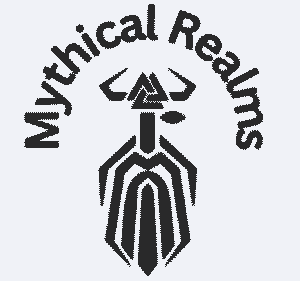Mythical Creatures and Symbols: A Cultural and Symbolic Exploration
1.1 Mythical Creatures and Symbols
These creatures and symbols were mighty representations of deeper cultural beliefs, human emotions, and existential concepts. They were often enough to personify natural forces, human virtues and vices, or cosmic struggles between order and chaos. All these mythical traditions have developed their unique creatures and symbols that express the values, strengths, and worldview of the society.
This content involves the most significant mythical creatures and symbols from five of the world’s leading mythological traditions: Norse, Greek, Indian, Egyptian, and Japanese. We will see how these creatures and symbols have produced the cultures that birthed them, how they reflect universal human themes, and how they still influence modern culture and thought.
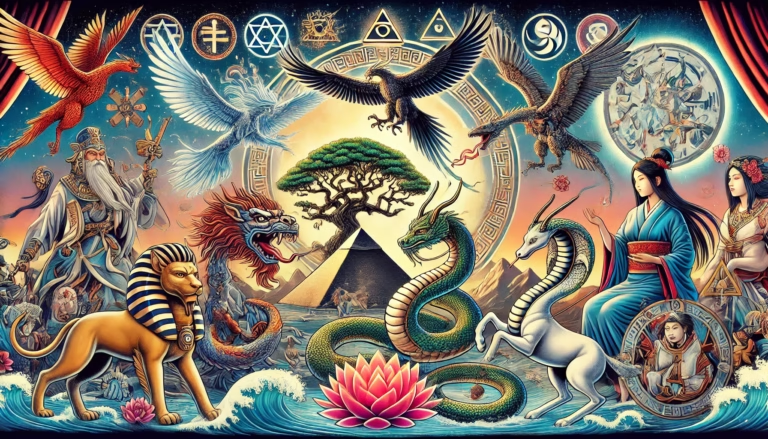
Section 1: Norse Mythical Creatures and Symbol & Their Meaning
2.1 Role of Mythical Creatures in Norse Culture
Norse mythology abounds with mythical creatures and symbols, of which many stand as metaphors for the bitter and capricious forces of nature, order against chaos, and the continuous warfare between the gods and giants. At the center of Norse mythology are the gods of Asgard, but the various creatures and symbols of it are of equal importance.
2.2 Main Norse Mythological Beings
2.2.1 Fenrir (The Wolf)
The most important creature of Norse mythology, Fenrir, is a monstrous wolf born to the trickster god Loki. According to myth, Fenrir is destined to kill Odin at Ragnarök, the end that is prophesied for the world. He symbolizes those uncontrollable forces of nature—powerful and wild, able even to bring down the greatest of gods.
Symbolic Meaning: Fenrir represents chaos, destruction, and the inevitability of fate. The wolf’s connection to the apocalyptic future also symbolizes the cyclical nature of life, where creation and destruction coexist in a never-ending loop.
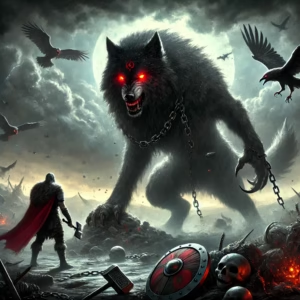
2.2.2 Jörmungandr (The Midgard Serpent)
The world-serpent, Jörmungandr, surrounds Midgard, or the world of humans, and is to face a final killing battle with Thor at Ragnarök. Its colossal size and command over the ocean symbolize how nature can also be infinite and challenge even gods.
Symbolic Meaning: Jörmungandr symbolizes the concept of creation and its destruction. As a snake, it represents change and renewal and this end also provides the Norse eschatology with a dramatic change of course.
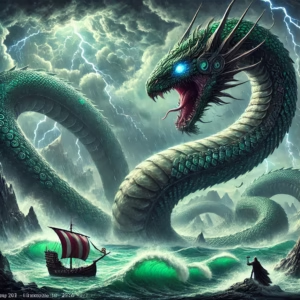
2.2.3 Sleipnir (Odin's Eight-Legged Horse)
Sleipnir, the eight-legged horse of Odin, is a symbol of swiftness, strength, and the ability to transcend boundaries. Sleipnir, born from Loki’s shape-shifting as a mare, is a direct representation of the liminal space between gods and giants.
Symbolic Meaning: Since Sleipnir has eight legs, these stand for where several worlds unite together-earth, sky and underworld. Because Sleipnir was known to ride and pass over both earthly and non-earthly surfaces, it reveals Odin’s full authority in dealing with life, death, or separation.

2.2.4 Valkyries
The Valkyries are warrior maidens who serve Odin, choosing who will die in battle and determining the fate of warriors. They are often depicted riding horses and wearing armor, and they guide chosen heroes to Valhalla, the hall of slain warriors.
Symbolic Meaning: The Valkyries symbolize fate, divine will, and the inevitability of death. They are both harbingers of destruction and protectors of the slain, so that warriors are given a place in the afterlife.

2.3 Norse Symbols
2.3.1 Mjölnir (Thor's Hammer)
Mjölnir, or Thor’s hammer, is the most recognizable symbol in Norse mythology. It’s a symbol that represents both destruction and protection: Thor uses his hammer to ward off giants on behalf of both gods and men. The hammer is also an emblem of fertility, as he used it to bless marriages and crops.
Symbolic Meaning : Mjölnir is interpreted as power, protection, and maintaining cosmic order. Their role for fertility and life-giving energy shows how the Norse realized their connection between destruction and creation.

2.3.2 The Valknut
The Valknut is a symbol associated with three interlocking triangles and is widely linked to Odin and the afterlife. Such a symbol is often used in Viking art pieces for burials and conveys themes of death, transformation, and one’s journey to the afterlife.
Symbolic Meaning: The Valknut symbolizes a binding between the physical and the spiritual realms. It denotes an association of life, death, and fate that awaits the soul, in addition to a strong duality associated with existence-the core theme found within Norse mythology.
Section 2: Greek Mythical Creatures and Symbols &Their Meaning
The part of fabulous brutes in Greek Culture. Greek tradition is full of a broad range of fabulous brutes, each representing mortal rates, moral assignments, and the ancient Greeks’ understanding of the macrocosm. They frequently interact with the gods, icons , and mortals in complex ways, emblematizing the interplay between fate, virtue, and the godly.
3.1 Main GreekMythological Beings
3.1.1 The Hydra
The Hydra is amulti-headed serpent- suchlike critter that regenerates two heads for every one that’s cut off. It represents the challenges of defying putatively endless problems and the consequences of trying to exclude wrong without understanding its nature.
Emblematic Meaning: The Hydra represents the idea that some problems or immoralities can not be canceled by brute force alone; they need wisdom and strategy to be overcome. It symbolizes the cyclical nature of conflict, where results may frequently give rise to new challenges.
3.1.2 The Minotaur
The Minotaur, a critter half- man and half- bull, lives in the maze designed by King Minos. Eventually, it’s defeated by the idol Theseus, representing the triumph of intellect and frippery over monstrous or primitive instincts.
Emblematic Meaning: The Minotaur is the struggle with inner darkness and primitive solicitations. The maze in which it lives symbolizes the complications of the mortal psyche and the trip toward tone- knowledge and mastery over one’s base instincts.
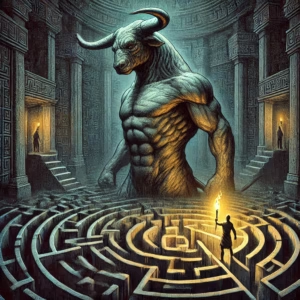
3.2.3 Cerberus
Cerberus is the three- headed canine that keeps the dead from escaping and prevents the living from entering the gates of the demiworld. Cerberus is an hallmark of life and death boundary.
Emblematic Meaning: The necessary nature of death and futurity of afterlife are embodied by Cerberus. Also, as the guardian of the demiworld, Cerberus stands for the protection and limitation contemporaneously.
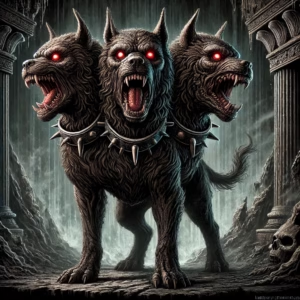
3.2 Greek Symbols
3.2.1 The Labrys
The labrys is described as a double-headed dismissal set up in Greek tradition, particularly from the Minoan civilization. It’s related with the goddess Demeter and represented power, fertility, and the omnipotence of the gods.
Symbolism Meaning: The labrys was a representation of the godly earth power and a cycle between life and death. Creation, because it’s associated with Demeter, and destruction, because it’s an armament of war.

3.2.2 The Laurel Wreath
The ensign wreath is largely associated with the Greek god Apollo and represents palm, honor, and achievement. It was given to athletes who won athletic competitions, similar as the Olympic Games, and to military leaders.
Emblematic Meaning: The ensign wreath is emblematic of success, godly favor, and the relationship between the mortal and the godly. It embodies the Greeks’ belief in excellence and the pursuit of glory in both intellectual and physical trials.
Section 3: Indian Mythical Creatures and Symbols & Their Meaning
The part of fabulous brutes in Indian culture. Indian tradition is a vast and intricate system of stories that blends divinities, brutes, and cosmic forces mythical creatures and symbols into a rich shade. brutes in Indian tradition frequently embody deeper philosophical and spiritual meanings, reflecting the complex interplay of good and evil, the cyclical nature of life, and the conception of dharma (righteousness), crucial Indian fabulous brutes.
4.1 Main Indian Mythological Beings
4.1.1 Garuda
Garuda is the vehicle of Lord Vishnu and symbolizes power, courage, and godly protection. He’s substantially depicted as a man with the bodies of an eagle, carrying a serpent in his hand.
Emblematic Meaning: Garuda represents the triumph of good over wrong, and his capability to overpower serpents symbolizes the destruction of ignorance and vision. He embodies godly strength and the power of righteousness.
4.1.2 Naga
The Nagas are serpent- suchlike,semi-divine or godly in Hindu, Buddhist, and Jain traditions. The Nagas live in the underground and have connotations of being associated with water, fertility, and the guarding of treasures.
Emblematic Meaning: The Nagas emblematize two aspects of life both that which brings to life and causes destruction by virtue of water; and deeper church associated with underground.
4.1.3 Rakshasas
Rakshasas are satanic beings that frequently represent wrong, chaos, and destruction. still, they also represent the negative situations of mortal nature rapacity, abomination, or lust.
Emblematic Meaning: It represents temptation of the material world and prostrating the darkness of undesirable studies, feelings, and passions in order to achieve spiritual enlightenment.
4.2 Indian Symbols
4.2.1 Om
The Om symbol is one of the most important spiritual symbols in Hinduism. It’s known to be the sound wthatvibrates the macrocosm. This is a mantra generally considered sacred, recapitulating the substance and the godly.
Emblematic Meaning: Om represents the interconnectedness of all effects, the cyclical nature of the macrocosm, and the ultimate reality or Brahman.
4.2.2 The Lotus
The lotus flower symbolizes chastity, enlightenment, and spiritual awakening. It grows in muddy waters but blooms pristinely, emblematizing the soul’s trip toward enlightenment despite worldly distractions.
Emblematic Meaning: The lotus represents spiritual growth, the emergence of chastity from within, and the trip toward tone- consummation.
Section 4: Egyptian Mythical Creatures and Symbols & Their Meaning
Role of fabulous brutes in Egyptian Culture
Egyptian culture is filled with gods, goddesses, and brutes representing natural forces, cosmos order, and afterlife. The brute representation symbolizes dominion exercised over the lives of others as well as their deaths in between two realms.
Some significant Egyptian fabulous brutes
5.1 Main Egyptian Mythological Beings
5.1.1 Sphinx
The Sphinx is an animal with a body of a captain and the head of a human. It stands for wisdom, protection, and the mystifications of life and death. The most notorious Sphinx stands at Giza, guarding the conglomerations.
Symbolic Meaning
The Sphinx is a symbol of the power of a captain and the wisdom of a human being. It is also an embodiment of veiling sacred knowledge. It represents riddle and the unattainable mysteries of God.
5.1.2 Anubis
Anubis is the jackal-headed god who presides over mummification and the afterlife. He is the protector of sepultures and the friend of the demiworld. Anubis supervises the journey of souls in the afterlife.
Symbolic Meaning: Anubis is the transition from life to death and the protection of the soul. His jackal form symbolizes the capability to navigate the liminal space between life and death.
Part 5: Japanese Mythical Creatures and Symbols & Their Meaning
The role of fabulous brutes in Japanese culture. Japanese tradition is highly associated with the Shinto religion, myth, and Buddhist traditions, which get godly numbers, spirits, and supernatural brutes mixed up into a rich shade of stories. In Japan, fabulous brutes are often deeply emblematic, representing various natural forces, godly power, and crossing the two worlds—thus the physical and the spiritual. Such brutes depict not only the artistic and religious convictions of the Japanese population but also become very important apologues for such individual as well as collective struggles.
Japanese mythological brutes constantly embody both defensive and destructive rates, which can be said to reflect the delicate balance between nature, mortal actuality, and the godly. They can be set up in reports, rituals, religious practices, and carnivals, and it continues to shape Japanese artistic identity indeed in the ultramodern period.
6.1 Main Japanese Mythological Beings
6.1.1 The Tengu
The Tengu are raspberry- suchlike brutes, often with mortal and avian features: a mortal body with a raspberry’s head, or a red face with a long nose. They are said to be found in mountains and timbers and are always roaming in remote regions. Sometimes they are presented as guardians of sacred spaces or supernatural soldiers.
Representative Symbol: Tengu are often handled as a kind of guardians or wardens and are especial located in mountainous surroundings or over areas one thinks of as sacred grounds. However, like any smart imp, they will also lecture sternly on haughtiness as well as how power might go to anyone’s head.
Tengu often has to represent the battle for civilization to push back on what is unruly in nature’s forces part in Folklore Tengu are always drawn as martial artists, teaching not only discipline but also the problems of overconfidence. In some stories, they said to challenge humans to conflicts that is both test and assignment.
6.1.2 Kappa
Kappa, one of the japanse mythical creatures and symbols. Kappa is an evil spirit, water imp, or demon who dwells in gutters, ponds, and morasses. Frequently represented as small, creatural brutes with green skin, a beak, and a dish- suchlike depression on their heads that holds water, Kappa are infamous for their prankish and sometimes destructive behavior. They like to issue sumo wrestling challenges to men, drown kids, or create chaos in the towns they haunt.
Iconic Signification: Kappa represents the unpredictable and volatile factors of nature. The head looks like a bowl, and the metaphor serves to signify balance between life and death. However, it then runs out of strength and becomes very weak, metaphoric for every effect needing an equal amount of balance, should a Kappa’s head lose the water.
In addition to this, Kappa teach respect for the natural basics and caution in dealing with unpredictable forces part in Folklore Kappa are often used as model numbers in myth. Parents would tell children that Kappa would drag them into the water if they acted out, buttressing respect for water bodies and the troubles they contain. Kappa also emblematize the duality of nature, as they can be both defensive and threatening.
6.1.3 Kitsune
In the Japanese tradition, kitsune or foxes are considered sacred brutes and almost associated with the Shinto god Inari. Kitsune said to have supernatural powers, for example, transforming into beautiful women or other brutes. It is also believed that they keep wisdom and act as defenders, couriers, and conjurers.
Kitsune are always symbolic of transformation, intellectuality, and church. Shaping their forms signifies how shape-shifting can essentially mean fluidity in identity and the mystery of the supernatural. As agents of Inari, kitsune also represent the idea of the will of gods, placing them as intercessors between gods and humans part in Folklore In stories, Kitsune can be both benevolent and malignant. While they may prop humans, offering guidance or protection, they’re also capable of deceiving or tricking those who fail to show them respect.
The complexity of their character illustrates the nebulosity of nature and the moral assignments about the consequences of one’s conduct.
6.1.4 Oni
Oni are gigantic, scary demons or ogres, typically depicted with red or blue skin, sharp claws, and cornucopias. According to Japanese mythology, Oni frighten townlets, wreaking havoc and mayhem. They are usually related to evil, and in most stories, they appear as enemies that must be overcome by icons.
Symbolic Meaning: Oni symbolize the destructive and chaotic forces that hang social order and harmony. They symbolize wrong, suffering, and mischance, but they also emblematize the natural balance between good and evil. Their intimidating appearance and strength make them redoubtable, yet they’re frequently portrayed as being defeated through courage and righteousness part in Folklore Oni are always portrayed as villains in narratives, often dethroned by heroes as legendary as Momotaro (Peach Boy).
In some interpretations, Oni also represent human flaws like greed and pride. They are used in mythology to teach tasks about the value of vanities, equity, and ethics.
6.1.5 Yuki-onna( The Snow Woman)
The female ghost, known as Yuki-onna, appears during snowfalls, which are typically described as dressed in white in beautiful form, so capable of inducing people to freeze up with an icy breath or aspect, and is also said to be drawn as a revenging spirit or a deception figure seeking to murder trippers.
Symbolic Meaning: The Yuki-onna is symbolic of the harshness and beauty of nature, especially the problems of idle time and the cold wave. She symbolizes themes of insulation, death, and the crossroads of the natural world with the supernatural.
Play her part in Folklore In the different performances of her story, Yuki-onna shows that she has softer sides, leaving her victims as long as they are pure or if they display rates similar as compassion. In this way, it points out to the binary death — both eluding and mystery — and that loss is both inevitable and pain.
6.2 Japanese Symbols
6.2.1 Torii Gate
The Torii gate is the symbol of gateway to a hallowed place of deification, veritably frequently erected near the entrance to Shinto tabernacles. The factual gate symbolises the separation of the profane and the religious worlds. typically it’s understood in terms of sanctification as well as in the trip of the soul to enlightenment.
Emblematic Significance: The Torii gate symbolizes the transition from the physical world to the spiritual world, an entrance and exit between the world of mortals and supernatural world. This gate symbolizes change, metamorphosis, and the hunt for enlightenment.
The Torii has been an integral part of the Shinto religion, with the conception that the world is filled with multitudinous spirits or kami and crossing over the gates is to enter the world of the gods.
6.2.2 Maneki-neko neko(The signaling Cat)
The Maneki-neko is the common term for the mascot in Japanese culture frequently set up in houses, stores, and coffee shops. Then, the cat is shown lifting one of the paws into a signaling position to be enabled to bring substance, wealth, and material substance.
Emblematic Meaning: The Maneki- neko is a symbol of good fortune and the protection of one’s home or business. Its raised paw represents an engagement for substance, and it’s constantly placed at entrances to attract good fortune.
The Maneki- neko is believed to have begun in Japan’s dealer class, whereby it was being used to drive down evil spirits and attract substance. It has come a way to be significantly deified as the symbol of luck not only in Japan but anywhere in the globe.
6.2.3 The Chrysanthemum
The Chrysanthemum is the public flower of Japan and is largely significant to the cultural and representational realm. It represents life, rejuvenation, and the spirit of the emperor. It also symbolizes the conception of perfection, with its intricate and symmetrical petals representing beauty and harmony.
Representational Meaning
The Chrysanthemum is a symbol of abidance, life, and respect for beauty. It’s also a symbol of the ephemerality of life as it flowers in afterlife, waving towards the end of the cycle of life.
The Chrysanthemum is associated with the Imperial Family and is frequently used in the crest of the Emperor, emblematizing the godly lineage and the living heritage of Japan’s Homeric heritage. It’s also employed in various art observances, analogous as the cyclical Chrysanthemum Festival.
6.2.4 The heritage of Japanese fantastic beasts and Icons
The fabulous beasties and symbols of Japanese tradition still have a important influence on the culture, art, and religion of Japan. numerous of these beasties and symbols are part of ancient tradition but are also alive in the modern world of Japan through literature, film, and popular culture, similar as in anime and manga.
For illustration, the Tengu has inspired characters in numerous ultramodern stories, whereas the Kitsune is still an integral part of tradition, with its transformative powers frequently explored in modern media. The Maneki- neko remains a important- favored icon of substance in businesses and homes, and the Torii gate remains a veritably recognizable image for spiritual travelers and sightseers likewise.
These beasties and symbols with their layers of meaning are still furnishing perceptivity to the Japanese worldview; a worldview emphasizing harmony with nature, respect for the unseen forces of the world, and the appreciation that evil and good are n’t always fluently defined.
Need Help?
FAQs
Fabulous beasties are emblematic numbers that represent cultural faith, feeling, and factualities. Frequently, they’re expressions of natural powers, merits, vices, and cosmic combat; they represent the vision of the world from which they’ve issued.
Fenrir, the monstrous wolf, symbolizes chaos, destruction, and the inevitability of fate. He also reflects the cyclical nature of life, where creation and destruction attend in a never-ending circle.
The hydra symbolizes the kind of problems or issues that grow back or multiply, signifying that some form of immorality can’t be completely excluded by force alone but have wisdom and strategy behind them to master.
The Naga represents both the origin-giving and destructive forces of water. They also represent spiritual sapience and protection, frequently associated with the netherworld.
Mjölnir represents power, protection, and cosmic order. It’s used by Thor both to destroy the elephants to cover gods and humans from their attacks and also to bless marriages and crops.
The Kitsune represents transformation, intelligence, and church. As a shape shifter, it symbolizes the fluidity of identity and the connection between humans and the godly.
The sphinx symbolizes wisdom, protection, and the mystifications of life and death. It represents the union of strength (captain) and intelligence (human) and guards sacred knowledge.
Tengu embody the balance between civilization and nature. They are guardians of sacred spaces, but their mischievous behavior also warns against arrogance and the abuse of power.
The valknut symbolizes the relationship between life and death and the fate of souls. It’s associated with the duality of actuality, while veritably frequently it’s connected to Odin and death in the afterlife.
The Maneki-neko, or “lucky cat,” symbolizes good fortune, substance, and the protection of one’s home or business. It’s generally displayed in homes and shops to attract positive energy and wealth.
